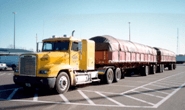Shipping and Logistics

Trucking: High Demand, High Driver Turnover
Written by Sandy Williams
June 12, 2018
Truck capacity continued to tighten and rates to escalate in June. Spot market demand increased last week across all truck types, said DAT Trendlines. Van rates were up 10 percent and average reefer rates 14 percent.
Rates for flatbed trucks, commonly used to transport steel and building materials, jumped another 6 cents to average $2.81 per mile, setting another all-time record. Rates ranged from $2.05 per mile in the West to $4.41 per mile in the Northeast.
The flatbed load-to-truck ratio rose 10 percent in the week ending June 9 to 109 loads per truck. National flatbed capacity was over 100 loads per truck for seven consecutive weeks through April and May, but last week’s jump created another new record.
The average flatbed load-to-truck ratio in May was 99.2 loads per truck, said DAT Trendlines, down 6 percent for the month, but 171 percent higher than May 2017, tightening the market and directly contributing to soaring rates.
The increase in demand has resulted in a surge in orders for new Class 8 trucks. ACT Research said preliminary order data for heavy duty trucks jumped 110 percent year-over-year in May to 35,600 vehicles.
“This is an astonishing rate of order placement,” said ACT Research President Kenny Vieth. “What’s facilitating it is that truckers are absolutely crushing it on freight rates and profitability right now.”
Demand for drivers in a tight labor market continues to frustrate the industry. The American Trucking Association reported that annualized turnover rates at large truckload carriers increased six points to 94 percent in first-quarter 2018 and is 20 percentage points higher than the same quarter a year ago.
ATA Chief Economist Bob Costello said that turnover is a measure of demand for drivers, not of driver shortage. “We know that as freight demand continues to rise, demand for drivers to move those goods will also rise, which often results in more driver churn or turnover. Finding enough qualified drivers remains a tremendous challenge for the trucking industry and one that if not solved will threaten the entire supply chain.”
“The uptick in turnover is consistent with continued tightness in the market for drivers,” Costello added. “Anecdotally, carriers continue to struggle both recruiting and retaining quality drivers, leading to increasing wages. The tight driver market should continue and will be a source of concern for carriers in the months ahead.”

Sandy Williams
Read more from Sandy WilliamsLatest in Shipping and Logistics

Wittbecker on Aluminum: US-China trade war clobbers cross-Pacific trade
Container shipping lines have sharply increased blank sailings on Transpacific routes in response to escalating trade tensions between the US and China.

Volvo plans to lay off up to 800 workers at US truck plants
The company cited uncertainty about freight rates and demand, regulatory changes and the impact of tariffs.

Trump signs executive order aimed at making US shipbuilding ‘great again’
President Trump on Wednesday signed an executive order meant to breathe new life into American shipbuilding and curb Chinese dominance in the sector.

Great Lakes iron ore trade fell again in March
Recall that shipments also saw a sharp decline in January.

Longshoremen ratify contract with maritime alliance
Nearly 99% of ILA members voted in favor of a new labor deal with the United States Maritime Alliance that covers workers at ports on the Atlantic and Gulf coasts.
